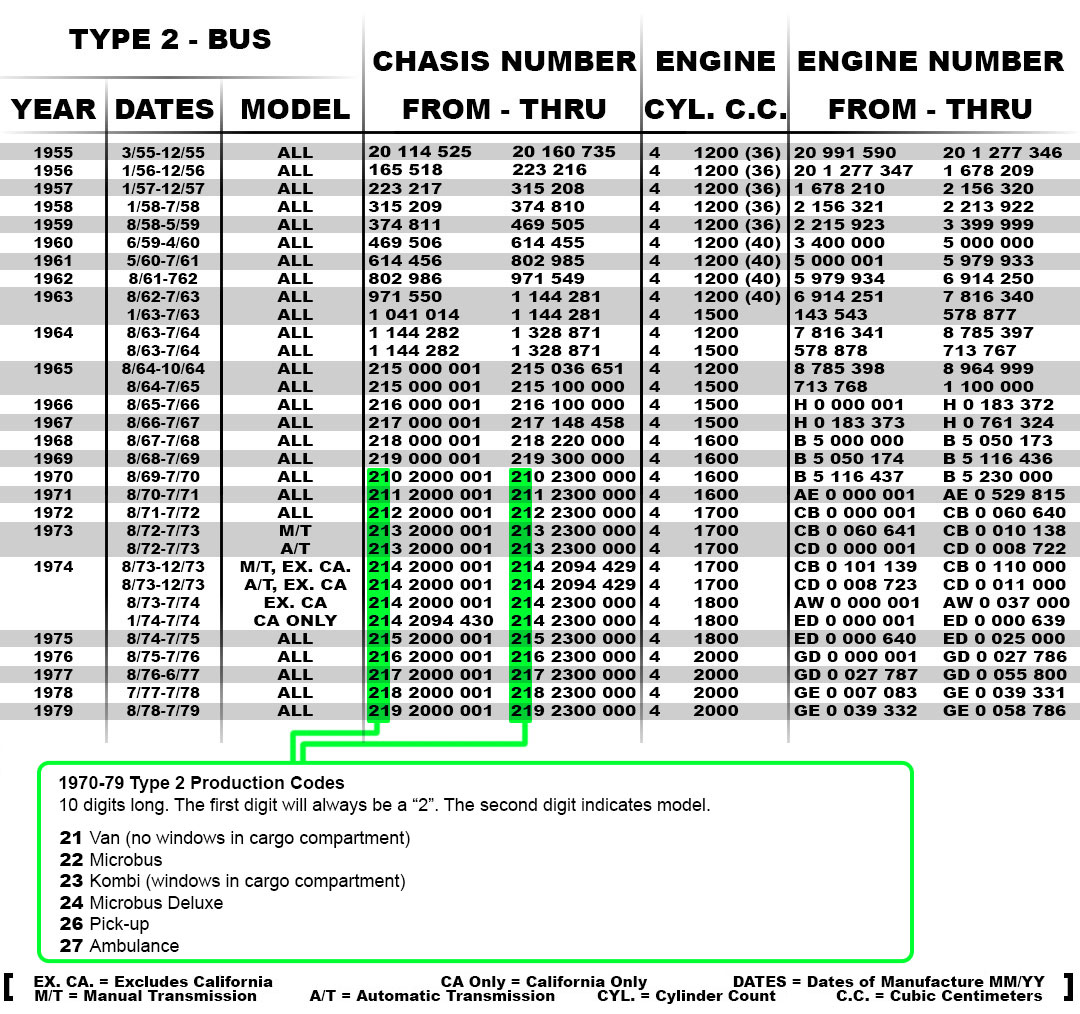Volkswagen Engine Serial Number Lookup
Volkswagen engines included the 1192, 1285, 1548, 1679, 1285 and the1493 cubic-centimeter models. However, Volkswagen rounded the engine sizes up, so a 1548 cubic centimeter engine is called a Volkswagen 1600. Identification of the Volkswagen engine can by accomplished by locating the engine casting number on the engine block.
- Air-Cooled VW Engine Identification Letter I.D. Codes & Displacement Chart Includes Type 1 (Beetle, Ghia, 181), Type 2 (Split & Bay Van), Type 3 (Variant) and Type 4 (411, 412, Bay Van and Porsche 914) Engine Codes. If You Find Any Engine Codes Not Listed Above Then Please Send a Description / Data To Us For Inclusion.
- Engine Codes. Chassis Numbers. 1945, Jan 45 - Dec 45, All, 1200, 077683 - 079093, 052000 - 053814, Narrow bumper with overiders. 1946, Jan 46 - Dec 46, All, 1200, 079093 - 090732, 053815 - 063796, Rim width increased to 5.0 inches. Jan 47 - Dec 47. All, 1200, 090732 - 0100788, 063796 - 072743.
Disclaimer: This tool is not the final authority on determining your year/make/model VW. Bodies, chassis, & parts can be switched and often are. All Information listed on this page is considered 'stock original specifications' for VW's destined to the US market. Always double check with your vehicle before ordering parts. We are not responsible for discrepancies.Always buy VW parts based on VIN numbers, do NOT trust the year written on your car title. A Beetle made in Germany in late 1966 that sat on a US dealership lot till the following year, might be listed as a 1967.

More About Volkswagen Vehicle IdentificationThe longevity of production with few fundamental changes paired with the interchangeability of air-cooled VW parts can make identifying your classic Volkswagen a challenge. The only sure-fire way to identify your VW is by checking the VIN. The Vehicle Identification Numbers are the numbers that correctly identify your vintage Volkswagen. VIN numbers can help you to identify the original parts that came stock in your VW and ensure that you order the correct parts for your vehicle. In some cases where vehicles had split production years VIN's are crucial to ordering the correct fit part. Below are images of vehicle identification number badges on a 1969 VW Beetle.The onset of mass vehicle production in the mid-1950s led to the inception of vehicle identification numbers. Automobile manufacturers began stamping the vehicles and their parts with unique VINs in order to give an accurate description of the mass produced vehicle.
For Classic Volkswagens, the Vehicle Identification Number (VIN) is particularly important. The chassis number on the car is the only sure-fire way to identify the origin of a VW. Because so many classic VW parts are interchangeable, the vehicles appearance and/or parts are not always telling of the vehicles origin.
Why is it important to identify the origin of your VW?The VIN on your classic Volkswagen is critical to identifying the stock parts that were used in your vehicle the year it was built. Your VW's identification number gives you the most accurate information about your vehicle.
All Volkswagens were built according to a calendar year prior to 1955. On August 1, 1955, 'a model year' was established. In some instanced, many exterior changes and inside improvements were made during a particular year's production. The older the VW, the more difficult it is to spot the changes. Before VIN numbers were standardized, VW used a combination of the Chassis Number and the Engine Code to convey information about the vehicles.
A standard format for vehicle identification didn't come about until the late 1970s. The VIN can be found in several locations, most commonly under the rear seat, on the door frame/post of the front doors, or on the dashboard near the windshield. Additionally, for the VW Bus, the VIN may be located on the car's firewall. The engine code may be found on the machine pad on front of the engine. These numbers are far more reliable than the information provided on the vehicle's title, registration or any other documents. We strongly advise that you purchase parts for your VW based on the VIN number and NOT on the year written on the vehicle's title.This video was made in house at JBugs and offer advice on purchasing an air-cooled VW restoration project car. The video also contains information about how and where to find the your VW Beetle's Identification Number.
Copyright © JBugs. All rights reserved. All images protected by US and International copyright laws. No part of this website may be reproduced, distributed, or transmitted in any form or by any means.All Prices subject to change without notice or obligation. Not responsible for typographical or photo errors. 'Volkswagen', 'VW','Beetle', 'Super Beetle', 'Bus', 'Ghia', 'Type 2', 'Type 3', 'Thing', 'Rabbit', 'Cabriolet', 'Jetta', and 'Golf' are trademarked by Volkswagen of America and are used for descriptive purposes only.
Vw Engine Serial Number Location
Volkswagen engines were first developed in Germany by Ferdinand Porsche during the 1930s. The Volkswagen Beetle would later become the most popular car in the world, partially because Volkswagen's air-cooled engines were reliable and easily swapped with other Volkswagen vehicles, regardless of model. Volkswagen engines included the 1192, 1285, 1548, 1679, 1285 and the1493 cubic-centimeter models. However, Volkswagen rounded the engine sizes up, so a 1548 cubic centimeter engine is called a Volkswagen 1600. Identification of the Volkswagen engine can by accomplished by locating the engine casting number on the engine block.